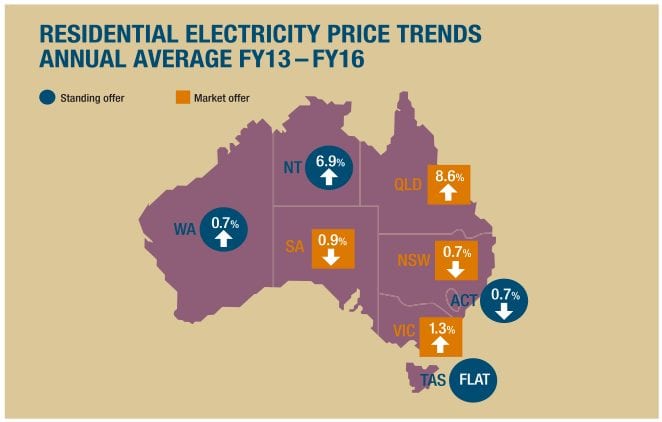Australian electricity prices are expected to stabilise in coming years, as the cost of environmental policies subsides, and the growth in network costs moderates, according to a new report prepared by the Australian Energy Markets Commission for the COAG meeting in Canberra on Friday. But the situation varies from state to state.
Queensland is expected to suffer the biggest prices increases in the years out to 2016, as suggested by the 13.5 per cent rise announced for 2014/15 earlier this week by the state government. Elsewhere, any price rises are moderate and in South Australia the retail price will fall – thanks mostly to the impact of renewable energy.
This graph gives a break-down on where the price components are heading. This is a national average, it should be noted. The price of carbon is coming down either way – because under the current policy the carbon price becomes a market-based one, and presumably much lower, or the current government succeeds in repealing it.
The cost of the large scale renewable energy target (mostly wind energy) is little changed, the cost of the small scale target (mostly rooftop solar) declines significantly, but is offset by the increased costs of state-based feed in tariffs – mostly as a result of bad management and the significant under-recovery of tariffs (particularly in Queensland) in past years.
Here’s the big swing factor for the business models of the incumbents, a graph (below) that reminds us of the dramatic change in demand. This little bell curve shows how demand was rising quickly in the late 2000s. It was presumed to continue, but the combination of price reaction, improving efficiency, declining manufacturing and rooftop solar caused it to fall just as dramatically. (This graph does not include rooftop solar produced on rooftops and consumed – that is seen as a subtraction from demand).
One interesting observation is that peak demand – once assumed to grow much faster than average demand – is now predicted to grow at the same rate as average demand, or even less. The AEMC says this should lead to more efficient use of the networks.
But it also leads to lower wholesale prices. The AEMC notes that wholesale prices (net of the carbon price) are at their lowest levels since the start of the National Electricity Market, and particularly so in South Australia, which has the highest penetration of renewable energy (more than 30 per cent from wind and household solar), and now the lowest average wholesale costs ($32/MWh in 2011/12). The AEMC notes this has forced some generators out of the market or caused them to shut down at certain times.
In the future, it says, the biggest reduction in wholesale prices could come in Victoria, where prices could fall 11 per cent below the base-case scenario.
The irony is that because of the way that the network charges are structured, the bigger the decrease in demand, the more that electricity charges for retail consumers are likely to rise, as this table below shows.















